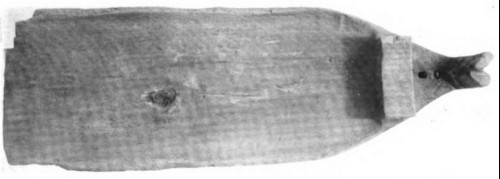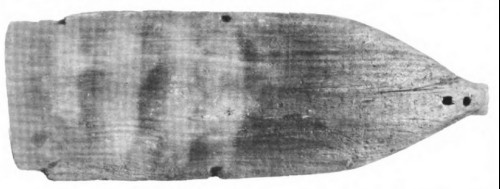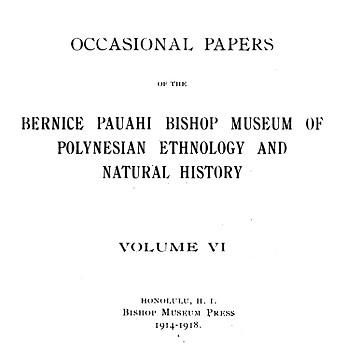surfresearch.com.au
 |
surfresearch.com.au
bishop museum : hawaiian sled,
1917
|
Bishop Museum
: Hawaiian Sled, 1914-1918.
Extract
from
Occasional
Papers of the Bernice
P. Bishop Museum.
Volume 6, 1914-1918.
Hathitrust
http://hdl.handle.net/2027/hvd.32044106182678
Introduction.
Description and
photographs of a sled or toboggan found in 1905
in a cave at Hookena, Hawaii, together with a small
surfboard of breadfruit.
Page 58.
[Sled-Toboggan]
Another specimen, a sled or toboggan, made of
breadfruit wood, is illustrated in Fig. 3, 4.
It was built like the bow of a native canoe,
with the upward curve of the prow ending in the usual finish
called the ihu.
Behind the ihu is a block correspond-
Page 59
Page 59


|
3.4. HAWAIIAN SLED OF BREADFRUIT
WOOD.
HENRIQUES
COLLECTION.
[Rotated]
|
Page 60
ing in
position with the main or umalu, the dasher of the canoe.
The
dish-like body of the toboggan is nearly flat on the bottom
and curves but slightly upward towards the edges where it
rises
more
abruptly to the rim.
The rim
begins at the block and continues along both sides to the
rear end.
There is no
rim across the rear end.
The total
length is 44.8 inches, width 15.5, length of body 34.5,
height of rim from bottom 1.5, thickness of bottom 1.2 in
middle and .5 at rear; block 7.2 long and 3.5 high and wide.
Through the
neck, between the ihu and the umalu, two holes
have been vertically cut (not drilled).
At various
points along the lower edge other holes have been cut
obliquely (Fig. 4), one on either side near the middle, two on
the left and one on the right near the end.
They were
skilfully made on a slant so as not to interfere with the
upper surface (Fig. 3).
When the
specimen was found there were heavy cords of braided coconut
fibre attached through the perforations.
The upper
surface is smooth, but the lower has been much scratched and
scored, as might result from dragging a heavy load over stones
or gravel.
Toward the
rear end this surface has been nearly worn through, the
thickness having been reduced more than a half.
All the
cutting has been done with a blunt implement, and the specimen
is undoubtedly ancient.
It was found
in 1905 in a cave at Hookena, Hawaii, together with a small
surfboard of breadfruit wood and several stone implements.
When found
both toboggan and surfboard were impregnated with salt.
Following the discovery, it was recollected by the older
natives at Hookena (according to a brief article in the
Commercial Adver-
tiser, Dec. 6,
1905) that their parents and grandparents had told them of a
certain chiefess named Kaneamuna who lived at Hookena in the
time of Keawenuiaumi, king of Hawaii.
Her principal
amusements were riding the surfboard and coasting down hill.
It was also
said that for the latter purpose she had a course built on a
hill back of Hookena and a sled made.
After her
death her sled and surfboard disappeared, and it was common
belief that those found in the cave were hers.
Page 61
The only type
of sled previously known to us, is that with long, slender
runners.
This Museum possesses one in complete condition and runners
for two more.
Our completed specimen, received from the former Government
Museum, consists of a pair of slender runners 11.5 feet long,
2.3 inches deep and 1 wide, set on edge, and kept in place—1.5
inches apart in front and 3 in rear (2.5 and 4 to centres)—by
cross braces lashed to the runners at intervals of about 11
inches.
On the braces is placed a platform of wood, bambu and matting,
4 inches wide, covering the runners except three feet in
front. The total height is 4.7 inches.*
Another pair of runners in the Museum collection is two feet
longer, but otherwise identical with those of the complete
specimen. All the runners are made of a very hard, durable
wood.
The sliding was done on steep hillsides on a course made by
clearing a track ten to twenty feet wide and covering this
with dry grass.
In some places the course was paved or built up with stone and
covered in the same way.
Remains of both kinds may still be found.
The sport was exclusively for men of chiefly rank, who
occasionally came to their death thereby.
When sliding they lay full length on the sled and the skill
required may be judged from its width.
Women did not follow this sport, although they were very
expert on the surfboard.
I do not know if the all-pervading kapu system was the reason,
but corpulence was a point of female beauty among the old
Hawaiians, which would naturally make this sled unpopular with
the sex.
I can find but one reference to a woman essaying the feat
(Ellis, Tour Through Hawaii, London, 1827, p. 291), where
Pele, the female Vulcan, appeared in human form and challenged
a chief on Hawaii to a race.
"Pele, less acquainted with the art of balancing herself on
the narrow sledge than her rival, was beaten ..."
An expected result of such an unbecoming attempt on the part
of a woman.
*This sled was
found in a burial cave in Puna, Hawaii, by the late Rufus
Lyman and by him given to King Kalakaua, from whom it came to
the Government Museum.
It is the most perfect specimen known.
Page 62
Returning to the Henriques specimen, we get some light on the
use of the toboggan from the fact that under the ancient
system
women of certain high rank were not permitted to walk—they
were carried.
It seems to me that this specimen may well have been the
private car of some chiefess who preferred this mode of
traveling.
In support of this I would refer to the position of the side
ropes placed so as not to interfere with the seating space;
the number of
ropes, indicating that numerous retainers were at command, and
their arrangement, such that the toboggan could be perfectly
controlled and so avoid an accident that might upset the
august personage or cause her discomfort.
Were the toboggan intended for human conveyance the position
naturally taken would be a seat, cross-legged or otherwise,
with the weight of the body on the rear end of the sled and
the block as a brace for the feet.
The excessive wear on the under surface at this place
indicates such a probability.
The precautions taken and the number of men required would
hardly be necessary, and the wear on the under surface would
have been more evenly distributed were the sled used for the
transportation of freight.
The fact that the toboggan was impregnated with salt, and its
resemblance to the bow of a canoe savors more of the sea
than the hills; the presence of salt would be accounted for if
one use of the sled was to carry Kaneamuna to and from the
ocean;
it was stated that surf riding was one of her amusements.
The use of any sled by a woman must have been a departure from
custom which was sufficiently novel to impress it on the
memory of fourteen generations, but it could not have become
general among women, or there would have been no comment at
all.
The use of a sled of this type must have been an isolated
case, or infrequent, or it would hardly have escaped attention
so long.
I cannot but believe that the tradition refers to the
Henriques specimen.
Page 141
Ethnology.
I quote from the report to me of Mr. J. F. G.Stokes, the
Curator:
"The number of specimens received during the year is
satisfactory and well up to the average, but not as large as
in the
previous year.
...
Mr. Henriques has added forty-three specimens to his
collection already on loan, the most important of which is the
small
breadfruit-wood surf board, found in the cave at Hookena with
the sled described last year.
The coconut scraper mentioned in the list was made from a
large cone shell, and is the first Hawaiian specimen of the
kind to be reported.
Page 159
List of Accessions.
...
By Loan
Edgar
Henriques, Honolulu. (L 925-967)
Shell coconut scraper, niho palaoa of limestone, olona board,
Niihau mat, awa mortar, 16 koko, hau rope, kahili handle tool,
2 wilrus tusks, 3 gourd bowls, Chinese shell trumpet, 4 gourd
bottles, fish line gourd, gourd syringe, basket, bambu braid,
olona net, coir net, surf board, shell trumpet, 2 kapa anvils.
Hawaiian Islands.

surfresearch.com.au
Geoff Cater (2016) : Bishop
Museum
: Hawaiian Sleds, 1918.
http://www.surfresearch.com.au/1918_Bishop_Museum_Papers.html



